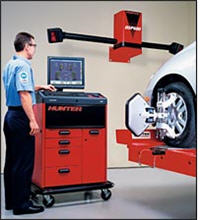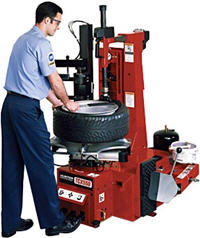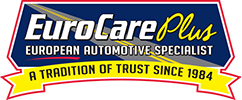Tire & Wheel Service and Repair
 Improve your vehicle’s handling, increase tire life, and drive with safety by checking your tires every month to insure that they are inflated with the right amount of air pressure. We offer a wide range of tires for your vehicle. Let our professionals help you find, balance, and mount the right tires for your car.
Improve your vehicle’s handling, increase tire life, and drive with safety by checking your tires every month to insure that they are inflated with the right amount of air pressure. We offer a wide range of tires for your vehicle. Let our professionals help you find, balance, and mount the right tires for your car.
Call or email us and let us help you with your tire services. Give us your tire size and we will email you a quote. We WILL BEAT any competitor’s written quote. We will not be undersold!
Below are some of the tire services that we offer:
- Wheel Alignment (Featuring our brand new state-of-the-art
- Computerized Camera Alignment System)
- Tire Mounting
- Tire Balancing
- Tire Rotation
- Tire Inspection
- Flat Repair

We also carry various tire brands. Here are some of the tire brands that we carry:
Tire Guide and Tips: Understanding Your Tire
For example, the number may read P225/70-R15, 89H:
P = Passenger Tire (LT = Light Truck)
- 225 = Overall width of the tire in millimeters
- 70 = Sidewall height (distance from rim to tread) as a percentage of the tread width (known as aspect ratio)
- R = Tire construction, this one is Radial (also, B = Belted Bias, D = Diagonal Bias
- 15 = Represents the size of the wheel in inches
- In this example, the tire has the number 89H. This is the weight capacity of the tire. However, in most cases, you will not see this heading on the sidewall.
- The V and Z rated tires have excellent dry pavement grip/traction but due to their soft rubber compounds, do not have a long life.
- A tread rating indicates how long a tire should last. This figure is written in small letters on the sidewall of your tire. The higher the number, the longer the tire should last. 100 is the basic tread wear rating.
- The traction rating works just like grading – ‘A’ being the best, ‘B’ is good, and ‘C’ is acceptable. This number is also found on the sidewall.
- Temperature ratings work the same – ‘A’ best, ‘B’ good, ‘C’ acceptable. If you drive your car very hard, you want a temperature rating of ‘A’ because a ‘C’ would fail faster under these conditions. Again, look for this number on the sidewall.
Alignment Service
Proper alignment is necessary for even tread wear and precise steering. A misaligned vehicle will also affect your gas mileage.
Q. How important is wheel alignment?
A. Research indicates that the average car is driven about 12,000 miles per year. A car with toe alignment just 0.34 degrees (Just 0.17 inches) out of specification has dragged its tires sideways for more than 68 miles by the end of the year!
Q. What are the symptoms of a car that’s out of alignment?
A. Have your car checked if you notice:
- Excessive or uneven tire wear.
- Steering wheel pulls to the left or right.
- Feeling of looseness or wandering.
- Steering wheel vibration or shimmy.
- Steering wheel is not centered when car is moving straight ahead.
Many vehicles today are equipped with rear suspensions that can be adjusted for alignment. Our ASE certified alignment technicians can tell you if your vehicle requires a two or four wheel alignment. With our state-of-the-art computerized alignment machines we will also provide you with a computer printout showing the adjustments that were made to your vehicle.
The most common adjustable angles are:
Toe
This refers to the tilted direction of the wheels toward or away from one another when viewed from the front. Toe is the most critical tire-wearing angle. Tires that “toe-in” point toward one another. Tires that “toe-out” point away from each other.
Camber
This refers to the tilt of the wheels toward or away from one another when viewed from the top. Wheels that tilt in toward the vehicle have “negative camber.” Wheels that tilt away from the vehicle have “positive camber.”
Caster
This refers to the angle of the steering axis in relation to an imaginary vertical line through the center of the wheel when viewed from the side. “Positive caster” is the term used when the vertical line is tilted back toward the rear. If it’s tilted forward, we call it “negative caster.” The proper caster angle stabilizes your car for better steering.
Thrust Angle This refers to the relationship of all four wheels to each other, as well as their relationship to an imaginary centerline that runs from bumper to bumper. The term “thrust line” refers to the direction in which the rear wheels are pointed. Thrust angle is correctable on cars with adjustable rear suspensions. If your car has a non-adjustable suspension, thrust-angle is compensated for by aligning the front wheels to the rear wheels.
Why Four Wheel Alignment?
Reduced Tire Wear
Improper alignment is a major cause of premature tire wear. Over the years, a properly aligned vehicle can add thousands of miles to tire life.
Better Gas Mileage
Gas mileage increases as rolling resistance decreases. Total alignment sets all four wheel parallel which, along with proper inflation, minimizes rolling resistance.
Improved Handling
Does your car pull to one side? Does the steering wheel vibrate? Do you constantly have to move the steering wheel to keep your car traveling straight ahead? Many handling problems can be corrected by total alignment. With all the system components aligned properly, road shock is more efficiently absorbed for a smoother ride.
Front End Inspection
A suspension system inspection is part of our alignment procedure. This allows us to spot worn parts before they cause costly problems.
Wheel alignments should be checked at least once per year or anytime you have your tires replaced. We would be happy to set up an appointment for you to check your wheel alignment. Our Free local courtesy shuttle can take you to work, home or to the local shopping mall! Otherwise, you can always reserve one of our complimentary loaner cars!
Euro Care Plus
1112 Hooksett Rd
Hooksett, NH 03106
603-644-7238
Business Hours:
7:30am - 5:00pm, Monday - Thursday
7:30am - 4:00pm, Friday



